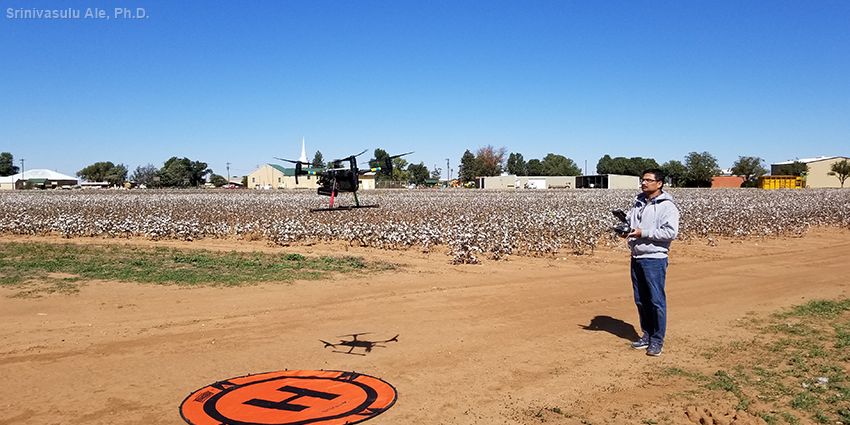Srinivasulu Ale, Ph.D., devotes his professional work to sustainable management of water resources on crop, pasture and grazing lands. Now an associate professor and geospatial hydrologist at the Texas A&M AgriLife Research Center at Vernon, Ale first became interested in water while growing up in rural India. There, he experienced and witnessed water insecurity on a regular basis.
“I saw the producers always had problems with uncertainties in the rainfall and had to deal with all the water shortages. So, I always wanted to be a water specialist; that’s made me more motivated to become a hydrologist,” he said.
“From the beginning, I was interested in water, water security and water quality-related issues. I always got fascinated by how to produce more crop per drop and how to efficiently use water resources on both crop and rangelands.”
Education and early career
Ale began his studies at Andhra Pradesh Agricultural University, now called Acharya N.G. Ranga Agricultural University, in India, earning a Bachelor of Science degree in agricultural engineering. Afterward, he attended G.B. Pant University of Agriculture and Technology in India, where he received a Master of Science degree in agricultural engineering with a specialization in irrigation and drainage engineering.
Ale then worked briefly as a research associate in the agriculture and rural development division at the Administrative Staff College of India before returning to Acharya N.G. Ranga Agricultural University as an assistant professor.
After 12 years as an assistant professor in soil and water engineering, Ale decided to earn his doctorate, to further advance his academic career.
“In 2004 I decided, okay, now I should do my Ph.D., and I always had a dream of doing it at a well-reputed university in the U.S.,” he said. “So I looked at different universities, applied, and then I landed at Purdue University.”
Once Ale received his doctorate in agricultural engineering in 2009, he continued his professional career at Purdue as a post-doctoral research associate in watershed hydrology. The next year, he joined the Texas A&M University System as an assistant professor of geospatial hydrology.
Research in the Midwest
Ale’s hydrology research interests changed as he moved from place to place. He said that it is important to think about hydrology locally, focusing on local issues that may address broader interests.
“For example, when I was doing my master’s and working at a land grant university in India as faculty, one of the main problems was waterlogging and salinization of irrigated agricultural lands. How we could reclaim those lands was interesting to me,” he said.
“When I came to Purdue, that helped me secure a graduate assistantship in the agricultural engineering department because I had some experience in reclaiming waterlogged lands.”
One way to reclaim both salt-affected and waterlogged soils is through subsurface (tile) drainage, an essential water management practice in the Midwest, where Purdue is located.
Ale said that the reason subsurface drainage is essential is because in the Midwest, rainfall is typically higher than the crop water requirement. This excess rainfall can cause problems on agricultural lands.
“Because soils are always wet, crop roots can’t get enough oxygen and the crops may not sustain. So for them, removal of excess water is a requirement to grow crops,” he explained.
However, when that excess water is drained, fertilizers and other chemicals applied to the crops leach out as well, eventually discharging into rivers and streams. The nutrient overload can promote excess algal growth and eventually create hypoxic zones, areas with low oxygen levels due to consumption of oxygen for decomposition of dead algae.
Ale’s research at Purdue investigated how nutrient leaching can be reduced by controlling the removal of excess water through drainage. He estimated nutrient load reduction through controlled drainage at the field and watershed scales using a deterministic drainage model.
Research in Texas
In Ale’s current geographic research area, the Texas High Plains and Rolling Plains, there isn’t a need for excess water removal. However, there’s a need for efficient water use because the amount of irrigation water taken from the underlying Ogallala and Seymour aquifers far exceeds the aquifers’ recharge rate. As a result, there’s been a rapid decline in groundwater levels.
“One of the important areas of my research program is to come up with efficient irrigation strategies so producers can conserve groundwater and extend the usable life of the aquifers while maintaining higher crop yields,” he said.
To create and evaluate these irrigation strategies, Ale uses crop growth models, such as for cotton. Cotton’s sensitivity to water stress changes based on the plant’s growth stage, so Ale’s team ran simulations of different irrigation scenarios and growth stages to suggest ideal irrigation strategies. He and his team also use crop growth models for other research, such as assessing the impact of climate change on Texas High Plains crop production and suggesting adaptation strategies.
Another important area of Ale’s research is to suggest innovative grazing management practices for conserving water and reducing downstream flood-risk, retaining nutrients, increasing soil carbon sequestration, and mitigating climate change effects in rangeland systems.
Ale’s latest research, which is part of a $10 million research project that started in fall 2021, focuses on regenerative agriculture practices. Ale said those practices can potentially improve soil health and mitigate the negative effects of climate change.
“For example, if the producer or the rancher adopts these kinds of regenerative practices over 20–30 years of time, how does that improve the soil carbon? How does that improve the water-holding capacity? How does that improve nutrient retention and water conservation?”
Ale will be taking field data collected by research team members to create and evaluate hydrologic and ecosystem models that represent experimental areas, which can then be used to predict long-term effects of implementing regenerative agricultural practices.
Looking to the future
Ale wants to continue developing and evaluating climate-resilient, regenerative agriculture practices that conserve soil and water, enhance crop productivity and protect soil and water quality. Recently, his team created a mobile app to help producers make better irrigation decisions. In the future, he wants to keep building such tools that help producers.
“Looking to the future, I would like to develop a real-time precision irrigation management decision support tool, whether it be a mobile app or a dashboard tool that producers can use to conserve water on their farms while achieving higher crop yields,” he said.
“I want to help producers and ranchers make better decisions, and hence my future research will focus on suggesting best management practices that improve resource use efficiency and then, at the same time, protect the soil and environment so that the current and future generations can benefit.”


